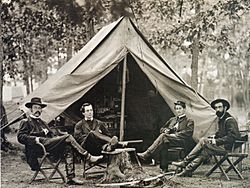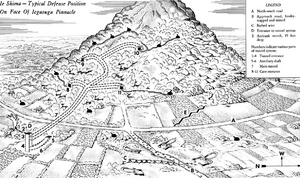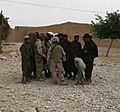Military intelligence facts for kids


Military intelligence is information about an enemy or possible enemy. It is information that has first been interpreted and evaluated. It can include the terrain, the weather, and any other information about a theater of operations. Military intelligence gathering has a long history.
History
By the time of the Battle of Kadesh in c. 1274 BC Egyptian Pharaoh Ramses II was known to have had court spies. In the biblical Book of Genesis Joseph thought his brothers were Canaanite spies.
The Chinese general and strategist Sun Tzu (544 BC – 496 BC) wrote about the importance of military intelligence. In his book The Art of War he wrote: "If you know both yourself and your enemy you can win a hundred battles without jeopardy." He emphasized the importance of using spies to learn an enemy's strength and what they were doing. He also wrote: "All warfare is based on deception". What he meant was war can even be avoided if you feed your enemy enough bad information. This is also called counterintelligence. Ancient Rome depended heavily on intelligence information to rule it's empire.
When Major General Joseph Hooker took command of the Army of the Potomac he ordered Colonel George H. Sharpe to establish an intelligence unit. In 1863, they established the Bureau of Military Information. The information they gathered was amazingly accurate. They calculated the size of the Confederate Army of Northern Virginia within 2% of the actual number. By war's end Sharpe knew more about the Army of Northern Virginia than many Confederate officers. One of the best sources of military information Sharpe's organization had was slaves who used the Underground Railroad to escape the South.
During World War I intelligence became better organized. For the first time Airplanes were used for intelligence gathering. An observer would fly with a pilot and diagram and map battlefields. They would also photograph intelligence targets and count troops. Operators at listening stations reported on enemy communications.
Climate
Before the 20th century accurate weather information was not available. Military planners had no data on the climate of their target area. In many cases they didn't even have accurate maps of the area. In 1941, when Nazi Germany invaded the Soviet Union they did not have any information on how harsh the Russian winters were. They did not have accurate maps of the roads. Between October 1941 and April 1942 the Germans lost between 100,000 and 112, 000 soldiers to frostbite. That is two-thirds of the number of soldiers who were killed in action or missing.
Terrain
General knowledge of terrain has always been important to military intelligence. But environmental factors sometimes went unnoticed. At the Battle of Agincourt mud was a major factor in the English victory. The extremely muddy ground slowed down the French and made them easy prey for English archers. In the 17th and 18th centuries army quartermasters, in addition to providing supplies, also scouted terrain and planned routes the army would take. One of the first major improvements in gaining scientific knowledge of terrain was during the Russo-Japanese War (1904–1905). The Russians used geologists to do a detailed survey of Korea. They also used geologists to advise them in building fortifications.
Having little or no knowledge of terrain has proved costly to many battles in history. During the Pacific War in World War II, the United States forces had little knowledge of the terrain of the many Pacific islands they fought on. After the war, the United States Army Corps of Engineers contracted with the United States Geological Survey to provide detailed geological information on occupied islands.
Modern military intelligence
In addition to intelligence gathering on other countries, terrorism is also a major concern of military intelligence. Intelligence gathering by examining communications signals has been a regular activity of military intelligence. Since 2005 military and other intelligence services have also monitored the Internet.
In some 21st century countries, military intelligence competes with civilian-led intelligence agencies. Often military and civilian intelligence gathering have different goals and objectives. Both gather their own intelligence and do not always share information. New methods of intelligence gathering, such as video imagery, satellites, reconnaissance aircraft and drones, produce tremendous amounts of raw data. Artificial intelligence is used to analyze this data for information.
Images for kids
See also
 In Spanish: Inteligencia militar para niños
In Spanish: Inteligencia militar para niños


